MVT-Like Fluorite Deposits and Oligocene Magmatic-Hydrothermal Fluorite–Be–U–Mo–P–V Overprints in Northern Coahuila, Mexico
Abstract
:1. Introduction
2. Regional Geology
3. Mineral Deposits of the Region
4. Mineralogy
4.1. MVT-like Fluorite Deposits
4.2. Fluorite–Be–U–Mo–P–V Associations
5. Fluid Inclusions
- Fluid inclusions in MVT-like deposits show temperatures of homogenisation (Th) that range between 50 °C and 152 °C and temperatures of ice melting (Tmi) that range between –4 °C and –11.5 °C, which correspond to calculated salinities between 5 and 15.5 wt.% NaCl equivalent. Such data are distributed among individual deposits as follows:
- (a)
- In the Buenavista deposit, Th range between 50 °C and 152 °C, Tmi range between –4 °C and –11.5 °C, and salinities range between 5 and 15.5 wt.% NaCl equivalent.
- (b)
- In the La Aurora deposit, Th range between 80 °C and 146 °C, Tmi range between –5.5 °C and –10.4 °C, and salinities range between 8.6 and 14.4 wt.% NaCl equivalent.
- (c)
- In the Korea deposit, Th range between 114 °C and 140 °C, Tmi range between –8.2 °C and –11 °C, and salinities range between 11.8 and 15 wt.% NaCl equivalent.
- Fluid inclusions in late fluorite–Be–U–Mo–V–P hydrothermal deposits show temperatures of homogenisation (Th) that range between 70 °C and 180 °C and temperatures of ice melting (Tmi) that range between –0.5 °C and –5.7 °C, which correspond to calculated salinities between 0.9 and 8.8 wt.% NaCl equivalent. Such data are distributed among individual deposits as follows:
- (a)
- In the Daniela deposit, Th range between 136 °C and 165 °C, Tmi range between −2 °C and −2.1 °C, and salinities range between 3.4 and 3.6 wt.% NaCl equivalent.
- (b)
- In the Aguachile deposit, Th range between 134 °C and 172 °C, Tmi range between −1.9 °C and −2.1 °C, and salinities range between 3.2 and 3.4 wt.% NaCl equivalent.
- (c)
- In the Cuatro Palmas deposit, Th range between 98 °C and 180 °C, Tmi range between −0.2 °C and −0.9 °C, and salinities range between 0.4 and 1.6 wt.% NaCl equivalent.
- (d)
- In the La Fácil deposit, Th range between 86 °C and 140 °C, Tmi range between −5 °C and −5.7 °C, and salinities range between 7.9 and 8.8 wt.% NaCl equivalent.
- (e)
- In the Las Alicias deposit, Th range between 70 °C and 128 °C, Tmi range between −0.5 °C and −1 °C, and salinities range between 0.9 and 1.7 wt.% NaCl equivalent.
- Fluid inclusions in the El Pilote fluorite skarn show temperatures of homogenisation (Th) that range between 78 °C and 394 °C. Temperatures of ice melting (Tmi) range between −3 °C and −11.5 °C for NaCl-dominated inclusion fluids with no daughter crystals, which correspond to calculated salinities between 5 and 15.5 wt.% NaCl equivalent. Temperatures of halite solubilisation (Ts) range between 180 °C and 230 °C for NaCl-dominated inclusion fluids with daughter halite crystals, which correspond to salinities between 30 and 34 wt.% NaCl. Tmi range between −27 °C and −42 °C for CaCl2-dominated inclusion fluids with no daughter crystals, which correspond to calculated salinities between 24.5 and 29.1 wt.% CaCl2.
6. Discussion
6.1. Constraints from Fluid Inclusions
6.2. Toward a Genetic Model for F–Be–U–Mo–P–V Deposits
6.3. Regional Implications
6.4. Sources of Fluids and Mechanisms of Mineralisation for F–Be–U–Mo–P–V Deposits
- F− was carried by hydrocarbon-rich saline basinal brines that were diluted by upwelling low-salinity magmatic fluids that carried Be (plus U and Mo) and the beryllium fluoride complexes thus formed were transported to shallow depths, with some participation of meteoric fluids heated by alkaline to calc-alkaline intrusives.
- Fluorite was dissolved from pre-existing MVT-like deposits by upwelling moderatery saline magmatic fluids that carried Be (plus U and Mo), such process released hydrocarbons contained in fluid inclusions, and the beryllium fluoride complexes thus formed were transported to shallow depths.
- Beryllium fluoride complexes (plus U, Mo, etc.) were exsolved from highly evolved alkaline to calc-alkaline intrusives along with moderately saline aqueous fluids, and some hydrocarbon-rich saline basinal brines were entrained by such fluids, with or without the entrainment of heated meteoric water.
7. Conclusions
Author Contributions
Funding
Acknowledgments
Conflicts of Interest
References
- González-Sánchez, F.; Camprubí, A.; González-Partida, E.; Puente-Solís, R.; Canet, C.; Centeno-García, E.; Atudorei, V. Regional stratigraphy and distribution of epigenetic stratabound clestine, fluorine, barite and Pb-Zn deposits in the MVT province of northeastern Mexico. Mineral. Deposita 2009, 44, 343–361. [Google Scholar] [CrossRef]
- González-Sánchez, F.; Puente-Solís, R.; González-Partida, E.; Camprubí, A. Estratigrafía del Noreste de México y su relación con los yacimientos estratoligados de fluorita, barita, celestina y Zn-Pb. Bol. Soc. Geol. Mex. 2007, 59, 32–45. [Google Scholar]
- Camprubí, A. Tectonic and metallogenic history of Mexico. In Tectonics, Metallogeny, and Discovery: The North American Cordillera and Similar Accretionary Settings; Colpron, M., Bissig, T., Rusk, B.G., Thompson, J.F.H., Eds.; Society of Economic Geologists: Littleton, CO, USA, 2013; Volume 17, pp. 201–243. [Google Scholar]
- González-Partida, E.; Camprubí, A.; Pironon, J.; Alfonso, P.; Cienfuegos-Alvarado, E.; Morales-Puente, P.A.; Canet, C.; González-Ruiz, L.E.; Díaz-Carreño, E.H. Modelo de formación de los yacimientos estratoligados de Cu en lechos rojos de Las Vigas (Chihuahua, México). Bol. Soc. Geol. Mex. 2017, 69, 611–635. [Google Scholar] [CrossRef]
- McAnulty, W.N.; Sewell, C.R.; Rasberry, J.M. Geology and Fluorspar ore Deposits in Cerro Aguachile, Pico Etereo District, Coahuila, Mexico; The Dow Chemical Company: Midland, MI, USA, 1960; unpublished report. [Google Scholar]
- McAnulty, W.N.; Sewell, C.R.; Atkinson, D.R.; Rasberry, J.M. Aguachile Beryllium-Bearing Fluorspar District, Coahuila, Mexico. Geol. Soc. Am. Bull. 1963, 74, 735–744. [Google Scholar] [CrossRef]
- Barker, D.S. Cenozoic magmatism in the Trans-Pecos province: Relation to the Rio Grande Rift. In Rio Grande Rift: Tectonics and Magmatism; Riecker, R.E., Ed.; American Geophysical Union: Washington, DC, USA, 1979; pp. 382–392. [Google Scholar]
- Griffin, W.R.; Foland, K.A.; Stern, R.J.; Leybourne, M.I. Geochronology of bimodal alkaline volcanism in the Balcones igneous province, Texas: Implications for Cretaceous intraplate magmatism in the northern Gulf of Mexico magmatic zone. J. Geol. 2010, 118, 1–21. [Google Scholar] [CrossRef]
- González-Partida, E.; Carrillo-Chávez, A.; Grimmer, J.O.W.; Pironon, J.; Mutterer, J.; Levresse, G. Fluorite deposits at Encantada-Buenavista, Mexico: Products of Mississippi Valley type processes. Ore Geol. Rev. 2003, 23, 107–124. [Google Scholar] [CrossRef]
- González-Partida, E.; Carrillo-Chávez, A.; Grimmer, J.O.W.; Pironon, J. Petroleum-rich fluid inclusions in fluorite, Purisima Mine, Coahuila, Mexico. Int. Geol. Rev. 2002, 44, 755–764. [Google Scholar] [CrossRef]
- González-Partida, E.; Camprubí, A.; Canet, C.; González-Sánchez, F. Fisicoquímica de salmueras e hidrocarburos en cuencas petroleras y en depósitos minerales tipo Mississippi Valley y asociados. Parte I: Temperatura, presión y composición de inclusiones fluidas. Bol. Soc. Geol. Mex. 2008, 60, 11–22. [Google Scholar]
- González-Partida, E.; Camprubí, A.; Canet, C.; González-Sánchez, F. Fisicoquímica de salmueras e hidrocarburos en cuencas petroleras y en depósitos minerales tipo Mississippi Valley y asociados. Parte II: Ejemplos de la Cuenca de Sabinas y la Cuenca del Sureste, México. Bol. Soc. Geol. Mex. 2008, 60, 23–42. [Google Scholar]
- Duex, T.W.; Henry, C.D. Uranium mobility in late magmatic and hydrothermal processes: Evidence from fluorite deposits, Texas and Mexico. In Uranium Deposits in Volcanic Rocks. Proceedings of a Technical Committee Meeting, El Paso, 1984; STI/PUB/690; International Agency of Atomic Energy (IAEA): Vienna, Austria, 1985; pp. 365–377. [Google Scholar]
- Smith, C.I. (Ed.) Review of the geologic setting, stratigraphy, and facies distribution of the Lower Cretaceous in Northern Mexico. In Lower Cretaceous Stratigraphy and Structure, Northern Mexico; West Texas Geological Society Publications: Midland, TX, USA, 1981; pp. 74–81. [Google Scholar]
- Eguiluz de Antuñano, S. Geologic Evolution and Gas Resources of the Sabinas Basin in Northeastern Mexico. In The Western Gulf of Mexico Basin; Bartolini, C., Buffler, R.T., Cantú-Chapa, A., Eds.; AAPG Memoir: Tulsa, OK, USA, 2001; Volume 75, pp. 241–270. [Google Scholar]
- Rivera-Martínez, C.; Santiago-Carrasco, B.; Barbosa-Luna, D. Informe Geológico—Minero de la Carta Cuatro Palmas h13-d38, Escala 1:50,000; Servicio Geológico Mexicano: Pachuca, Hidalgo, Mexico, 2005.
- Daugherty, F.W. Geology of the Pico Etéreo Area, Acuña Municipality, Coahuila. Ph.D. Dissertation, University of Texas at Austin, Austin, TX, USA, 1962. [Google Scholar]
- Sánchez-Bermeo, G.; Jiménez-Hernández, A.; Caballero-Martínez, J.A. Informe de la Carta Geológico-Minera Manuel Benavides Clave H13-9, Escala 1,250,000, Estados de Coahuila y Chihuahua; Consejo de Recursos Minerales, Gerencia de Geología y Geoquímica, Oficina Regional Coahuila: Saltillo, Coahuila, Mexico, 2002; 100p. [Google Scholar]
- Price, J.G.; Henry, C.D. Stress orientations during Oligocene volcanism in the Trans-Pecos Texas: Timing the transition from Laramide Compression to Basin and Range tension. Geology 1984, 12, 238–241. [Google Scholar] [CrossRef]
- Levresse, G.; Tritlla, J.; Villareal, J.; González-Partida, E. The “El Pilote” fluorite skarn: A crucial deposit in the understanding and interpretation of the origin and mobilization of F from northern Mexico deposits. J. Geochem. Explor. 2006, 89, 205–209. [Google Scholar] [CrossRef]
- Levresse, G.; Tritlla, J.; Solorio-Munguía, J.G.; Valencia, V.; Pinto-Linares, P.J. Fluid inclusions and U/Pb dating of the El Pilote Fluorite skarn occurrence: Metallogenic implications. Compt. Rendus Geosci. 2011, 343, 342–350. [Google Scholar] [CrossRef]
- Kesler, S.E. Informe Final Sobre el Proyecto de Fluorita en Yacimientos de Fluorita y de Plomo-Zinc-Plata; Consejo de Recursos Minerales: Pachuca, Mexico, 1974; 114p, Unpublished report. [Google Scholar]
- Chairez-Blanco, J.; Flores, T. Informe de la Visita de Reconocimiento de la Parte Central de la Sierra La Vasca, Localizada en el Municipio de Ocampo, Coahuila; Consejo de Recursos Minerales: Pachuca, Hidalgo, Mexico, 1983; 12p, Unpublished report. [Google Scholar]
- Orozco-Jiménez, R. Reconocimiento Geológico-Minero de la Sierra de la Vasca, Municipio de Ocampo, Coahuila; Consejo de Recursos Minerales: Pachuca, Hidalgo, Mexico, 1985; 14p, Unpublished report. [Google Scholar]
- Sánchez-Alvarado, P.; Pérez-Martínez, H.; González-Faustino, G.; Olvera-Cano, M.A. Estudio Geológico del Área de La Morena, Municipio de Ocampo, Coahuila; Consejo de Recursos Minerales: Pachuca, Hidalgo, Mexico, 1985; 111p, Unpublished report. [Google Scholar]
- Iriondo, A.; Kunk, M.J.; Winick, J.A.; CRM. 40Ar/39Ar Dating Studies of Minerals and Rocks in Various Areas in Mexico: USGS/CRM Scientific Collaboration (Part I); USGS Open-File Report 03-020; United States Geological Survey: Denver, CO, USA, 2003.
- Iriondo, A.; Kunk, M.J.; Winick, J.A.; CRM. 40Ar/39Ar Dating Studies of Minerals and Rocks in Various Areas in Mexico: USGS/CRM Scientific Collaboration (Part II); USGS Open-File Report 04-1444; United States Geological Survey: Denver, CO, USA, 2003.
- Takeda, H. Las Características de la Mineralización de los Depósitos de Plomo-Zinc-Plata en las Calizas de la Parte Norte de la Sierra Madre Oriental, México; Consejo de Recursos Minerales, VI Seminario Interno Sobre Exploración Geológico-Minera: Pachuca, Hidalgo, Mexico, 1977; pp. 239–277. [Google Scholar]
- Chairez-Blanco, J. El Yacimiento de Au, Ag y Cu de Mina Fronteriza, Mpio. de Ocampo, Coah; Consejo de Recursos Minerales: Pachuca, Hidalgo, Mexico, 1993; 11p, Unpublished report. [Google Scholar]
- Ostendorf, J.; Henjes-Kunst, F.; Schneider, J.; Melcher, F.; Gutzmer, J. Genesis of the carbonate-hosted tres marias Zn-Pb-(Ge) deposit, Mexico: Constraints from Rb-Sr sphalerite geochronology and Pb isotopes. Econ. Geol. 2017, 112, 1075–1087. [Google Scholar] [CrossRef]
- Camprubí, A. The metallogenic evolution in Mexico during the Mesozoic, and its bearing in the Cordillera of Western North America. Ore Geol. Rev. 2017, 81, 1193–1214. [Google Scholar] [CrossRef]
- Levresse, G.; González-Partida, E.; Tritlla, J.; Camprubí, A.; Cienfuegos-Alvarado, E.; Morales-Puente, P. Fluid origin of the world-class, carbonate-hosted Las Cuevas fluorite deposit (San Luis Potosí, Mexico). J. Geochem. Explor. 2003, 78–79, 537–543. [Google Scholar] [CrossRef]
- McLemore, V.T. Rare Earth Elements (REE) Deposits Associated with Great Plain Margin Deposits (Alkaline-Related), Southwestern United States and Eastern Mexico. Resources 2018, 7, 8. [Google Scholar] [CrossRef]
- Levinson, A.A. Beryllium-fluorine mineralization at Aguachile Mountains, Coahuila, Mexico. Am. Mineral. 1962, 47, 67–74. [Google Scholar]
- Bodnar, R.J. Revised equation and table for determining the freezing point depression of H2O-NaCl solutions. Geochim. Cosmochim. Acta 1993, 57, 683–684. [Google Scholar] [CrossRef]
- Bodnar, R.J.; Sterner, S.M.; Hall, D.L. SALTY: A FORTRAN program to calculate compositions of fluid inclusions in the system NaCl-KCl-H2O. Comput. Geosci. 1989, 15, 19–41. [Google Scholar] [CrossRef]
- González-Partida, E.; Camprubí, A.; Carrillo-Chávez, A.; Díaz-Carreño, E.H.; González-Ruiz, L.E.; Farfán-Panamá, J.L.; Cienfuegos-Alvarado, E.; Morales-Puente, P.; Vázquez-Ramírez, J.T. Giant fluorite mineralization in Central Mexico by means of exceptionally low salinity fluids: An unusual style among MVT deposits. Minerals 2019, in press. [Google Scholar]
- González-Partida, E.; Camprubí, A. Evolution of mineralizing fluids in the Zn-Pb-Cu(-Ag±Au) skarn and epithermal deposits of the world-class San Martín district, Zacatecas, Mexico. J. Geochem. Explor. 2006, 89, 138–142. [Google Scholar] [CrossRef]
- Ruiz, J.; Kesler, S.E.; Jones, L.M.; Sutter, J.F. Geology and geochemistry of the Las Cuevas fluorite deposit, San Luis Potosí, México. Econ. Geol. 1980, 75, 1200–1209. [Google Scholar] [CrossRef]
- Lyons, J.I. Geology and ore deposits of the Bolaños silver district, Jalisco, Mexico. Econ. Geol. 1988, 83, 1560–1582. [Google Scholar] [CrossRef]
- Scheubel, F.R.; Clark, K.F.; Porter, E.W. Geology, tectonic environment, and structural controls in the San Martín de Bolaños district, Jalisco, Mexico. Econ. Geol. 1988, 83, 1703–1720. [Google Scholar] [CrossRef]
- Albinson, T.; Norman, D.I.; Cole, D.; Chomiak, B. Controls on the formation of low-sulfidation epithermal deposits in Mexico: Constraints from fluid inclusions and stable isotope data. Soc. Econ. Geol. Spec. Publ. 2001, 8, 1–32. [Google Scholar]
- Albinson, T.; Rubio, M.A. Mineralogic and thermal structure of the Zuloaga vein, San Martín de Bolaños District, Jalisco, Mexico. Soc. Econ. Geol. Spec. Publ. 2001, 8, 115–132. [Google Scholar]
- Huspeni, J.R.; Kesler, S.E.; Ruiz, J.; Tuta, Z.; Sutter, J.F.; Jones, L.M. Petrology and geochemistry of rhyolites associated with tin mineralization in northern Mexico. Econ. Geol. 1984, 79, 87–105. [Google Scholar] [CrossRef]
- Camprubí, A.; Albinson, T. Epithermal deposits in México—An update of current knowledge, and an empirical reclassification. In Geology of México: Celebrating the Centenary of the Geological Society of México; Alaniz-Álvarez, S.A., Nieto-Samaniego, A.F., Eds.; Geological Society of America Special Paper; Geological Society of America: Boulder, CO, USA, 2007; Volume 422, pp. 377–415. [Google Scholar]
- Zhang, W.; Zhou, L.; Tang, H.; Li, H.; Song, W.; Xie, G. The solubility of fluorite in Na-K-Cl solutions at temperatures up to 260 °C and ionic strengths up to 4 mol/kg H2O. Appl. Geochem. 2017, 82, 79–88. [Google Scholar] [CrossRef]
- Trueman, D.L.; Sabey, P. Beryllium. In Critical Metals Handbook; Gunn, G., Ed.; John Wiley & Sons: New York, NY, USA, 2013; pp. 99–121. [Google Scholar]
- Bulnaev, K.B. Origin of the fluorite-bertrandite-phenakite deposits. Geol. Ore Dep. 1996, 38, 128–136. [Google Scholar]
- Bulnaev, K.B. Fluorine-beryllium deposits of the Vitim Highland, western Transbaikal region: Mineral types, localization conditions, magmatism, and age. Geol. Ore Dep. 2006, 48, 277–289. [Google Scholar] [CrossRef]
- Kupriyanova, I.I.; Kukushkina, O.A.; Shpanov, E.P.; Kuvshinova, K.A. Fluorite Properties and Formation Conditions at the Beryllium-Fluorite Deposits in the Voznesensk Ore District (Far East Region). Geol. Ore Dep. 2001, 43, 481–493. [Google Scholar]
- Stel’machonok, K.Z.; Ishkov, Y.M. Metal content of ore-forming solutions of the Ermakovka beryllium deposit (Western Transbaikalia). Geol. Geofiz. 2001, 42, 802–814. [Google Scholar]
- Aleksandrov, S.M. Skarn-greisen deposits of the Lost River and Mount Ear ore field, Seward Peninsula, Alaska, United States. Geochem. Int. 2010, 48, 1220–1236. [Google Scholar] [CrossRef]
- Li, X.; Wang, G.; Mao, W.; Wang, C.; Xiao, R.; Wang, M. Fluid inclusions, muscovite Ar–Ar age, and fluorite trace elements at the Baiyanghe volcanic Be–U–Mo deposit, Xinjiang, northwest China: Implication for its genesis. Ore Geol. Rev. 2015, 64, 387–399. [Google Scholar] [CrossRef]
- Reyf, F.G.; Karmanov, N.S.; Ishkov, Y.M. Acid Be solutions at the Orot deposit and their relation to the intrusion of alkaline granites. Dokl. Earth Sci. 2005, 405, 1257–1260. [Google Scholar]
- Grew, E.S.; Hazen, R.M. Beryllium mineral evolution. Am. Mineral. 2010, 99, 999–1021. [Google Scholar] [CrossRef]
- Steenfelt, A.; Kolb, J.; Thrane, K. Metallogeny of South Greenland: A review of geological evolution, mineral occurrences and geochemical exploration data. Ore Geol. Rev. 2016, 77, 194–245. [Google Scholar] [CrossRef]
- Burt, D.M.; Sheridan, M.F. Model for the formation of uranium/lithophile element deposits in fluorine-rich volcanic rocks. In Uranium in Volcanic and Volcaniclastic Rocks; Goodell, P.C., Waters, A.C., Eds.; AAPG Studies in Geology; American Association of Petroleum Geologists: Tulsa, OK, USA, 1980; Volume 13, pp. 99–110. [Google Scholar]
- Dai, S.; Wang, X.; Seredin, V.V.; Hower, J.C.; Ward, C.R.; O’Keefe, J.M.K.; Huang, W.; Li, T.; Li, X.; Liu, H.; et al. Petrology, mineralogy, and geochemistry of the Ge-rich coal from the Wulantuga Ge ore deposit, Inner Mongolia, China: New data and genetic implications. Int. J. Coal Geol. 2012, 90–91, 72–99. [Google Scholar] [CrossRef]
- Etschmann, B.; Liu, W.; Li, K.; Dai, S.; Reith, F.; Falconer, D.; Kerr, G.; Paterson, D.; Howard, D.; Kappen, P.; et al. Enrichment of germanium and associated arsenic and tungsten in coal and roll-front uranium deposits. Chem. Geol. 2017, 463, 29–49. [Google Scholar] [CrossRef]
- Wood, S.A. Theoretical prediction of speciation and solubility of beryllium in hydrothermal solution to 300 °C at saturated vapor pressure: Application to bertrandite/phenakite deposits. Ore Geol. Rev. 1992, 7, 249–278. [Google Scholar] [CrossRef]
- Cárdenas-Flores, D. Volcanic stratigraphy and U-Mo mineralisation of the Sierra de Peña Blanca district, Chihuahua, México. In Uranium Deposits in Volcanic Rocks. Proceedings of a Technical Committee Meeting, El Paso, 1984; STI/PUB/690; International Agency of Atomic Energy (IAEA): Vienna, Austria, 1985; pp. 125–136. [Google Scholar]
- George-Aniel, B.; Leroy, J.; Poty, B. Uranium deposits of the Sierra Peña Blanca: Three examples of mechanisms of ore deposit formation in a volcanic environment. In Uranium Deposits in Volcanic Rocks. Proceedings of a Technical Committee Meeting, El Paso, 1984; STI/PUB/690; International Agency of Atomic Energy (IAEA): Vienna, Austria, 1985; pp. 175–186. [Google Scholar]
- George-Aniel, B.; Leroy, J.; Poty, B. Volcanogenic uranium mineralisations in the Sierra Pena Blanca District, Chihuahua, Mexico: Three genetic models. Econ. Geol. 1991, 86, 233–248. [Google Scholar] [CrossRef]
- Goodell, P.C. Chihuahua City uranium province, Chihuahua, Mexico. In Uranium Deposits in Volcanic Rocks. Proceedings of a Technical Committee Meeting, El Paso, 1984; STI/PUB/690; International Agency of Atomic Energy (IAEA): Vienna, Austria, 1985; pp. 97–124. [Google Scholar]
- Locardi, E. Uranium in acidic volcanic environments. In Uranium Deposits in Volcanic Rocks. Proceedings of a Technical Committee Meeting, El Paso, 1984; STI/PUB/690; International Agency of Atomic Energy (IAEA): Vienna, Austria, 1985; pp. 17–28. [Google Scholar]
- Reyes-Cortés, M. Depósito de molibdeno asociado con uranio en Peña Blanca, México. In Uranium Deposits in Volcanic Rocks. Proceedings of a Technical Committee Meeting, El Paso, 1984; STI/PUB/690; International Agency of Atomic Energy (IAEA): Vienna, Austria, 1985; pp. 161–174. [Google Scholar]
- Wenrich, K.J. Geochemical characteristics of uranium-enrichedvolcanic rocks. In Uranium Deposits in Volcanic Rocks. Proceedings of a Technical Committee Meeting, El Paso, 1984; STI/PUB/690; International Agency of Atomic Energy (IAEA): Vienna, Austria, 1985; pp. 29–51. [Google Scholar]
- Burt, D.M.; Sheridan, M.F.; Bikun, J.V.; Christiansen, E.H. Topaz rhyolites—Distribution, origin, and significance for exploration. Econ. Geol. 1982, 77, 1818–1836. [Google Scholar] [CrossRef]
- Christiansen, E.H.; Burt, D.M.; Sheridan, M.F.; Wilson, R.T. The petrogenesis of topaz rhyolites from the western United States. Contrib. Mineral. Petrol. 1983, 83, 16–30. [Google Scholar] [CrossRef]
- Burt, D.M.; Sheridan, M.F. Types of mineralisation related to fluorine-rich silicic lava flows and domes. Geol. Soc. Am. Spec. Paper 1987, 212, 103–109. [Google Scholar]
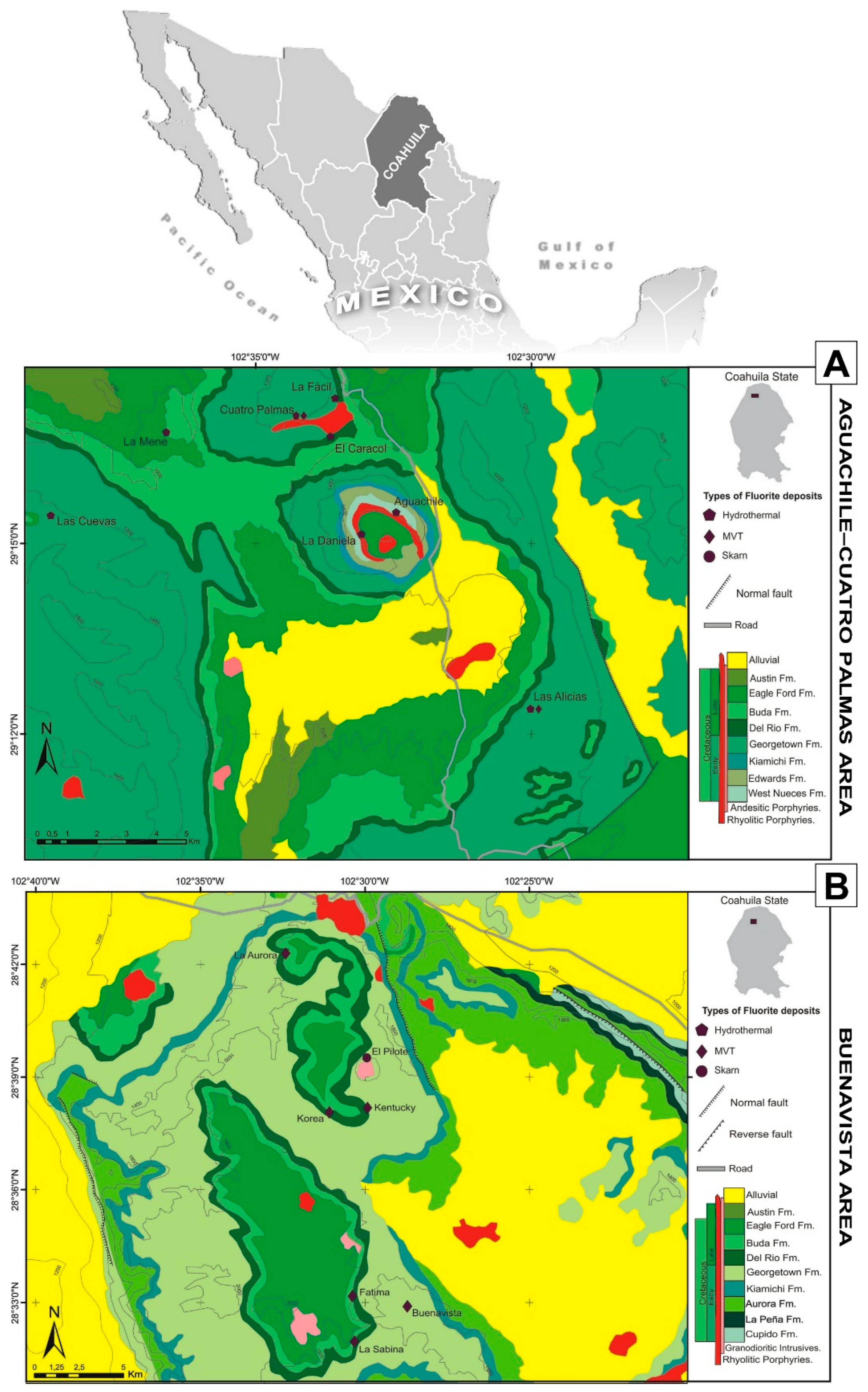
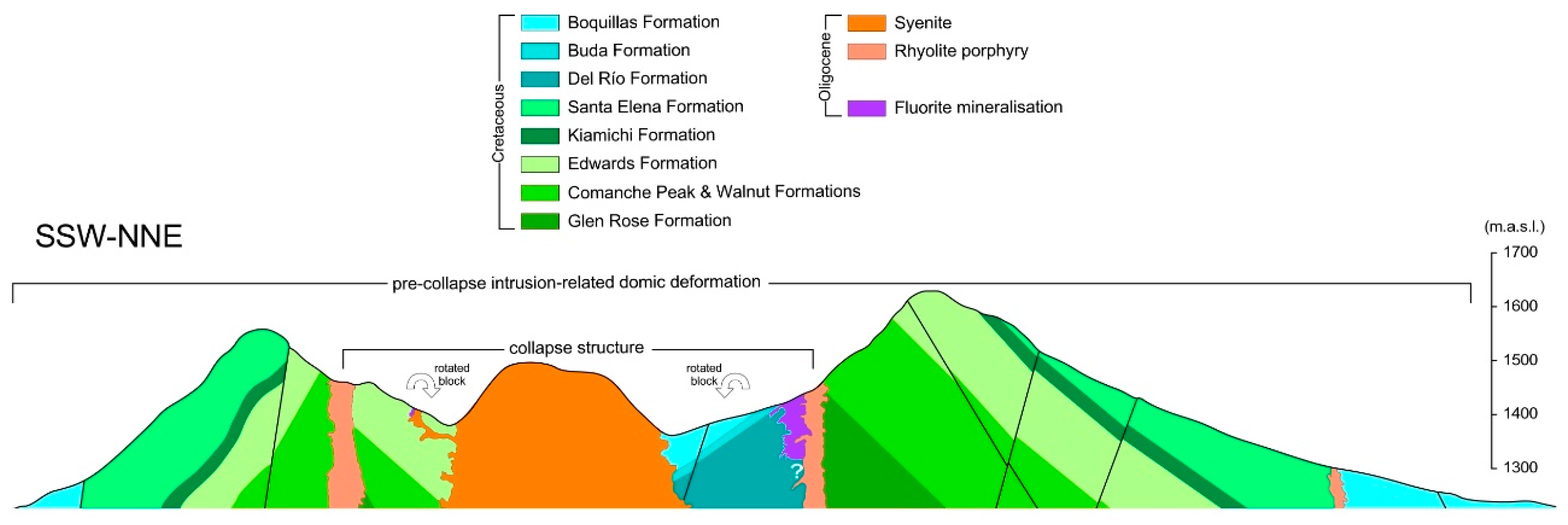
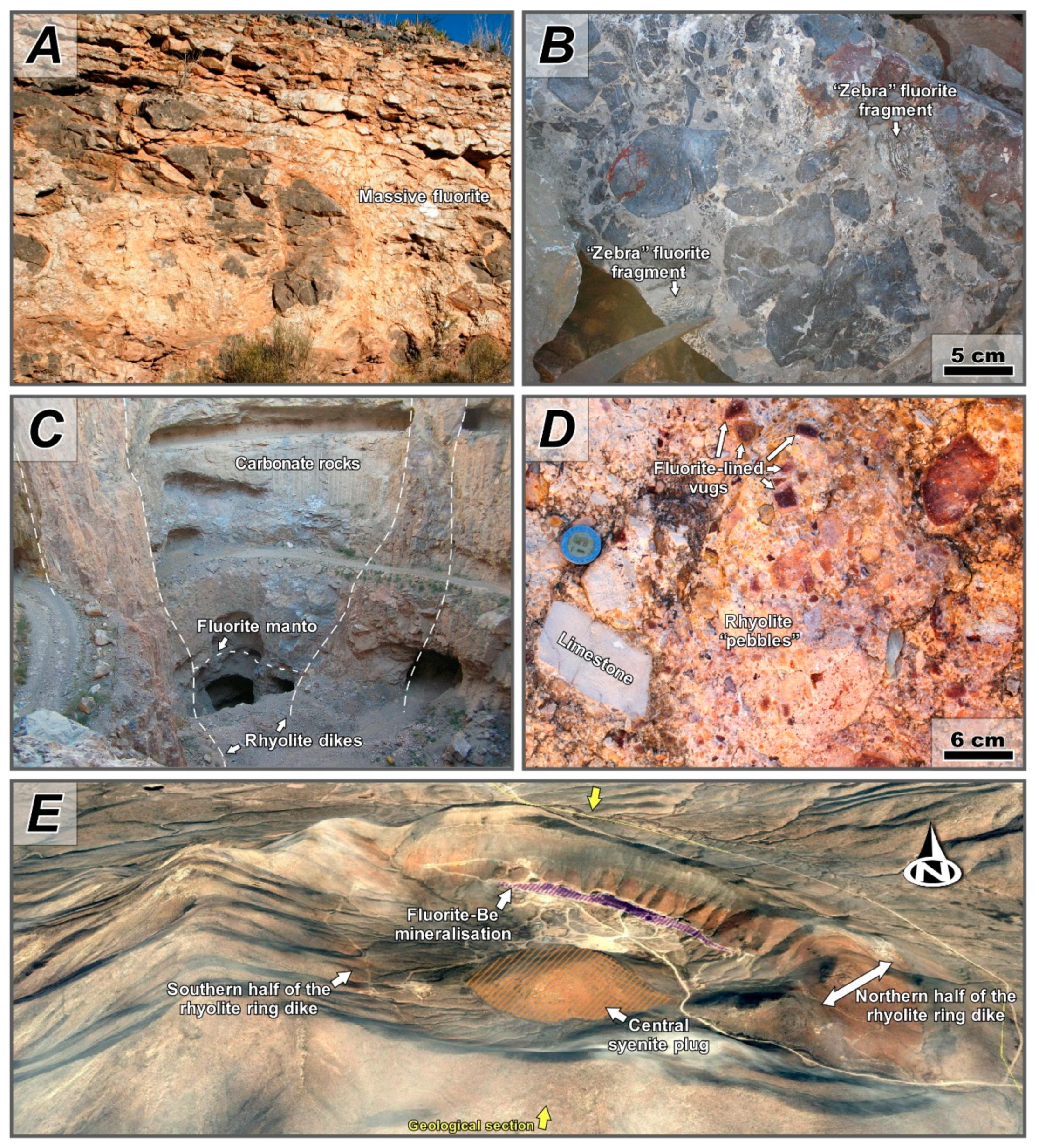
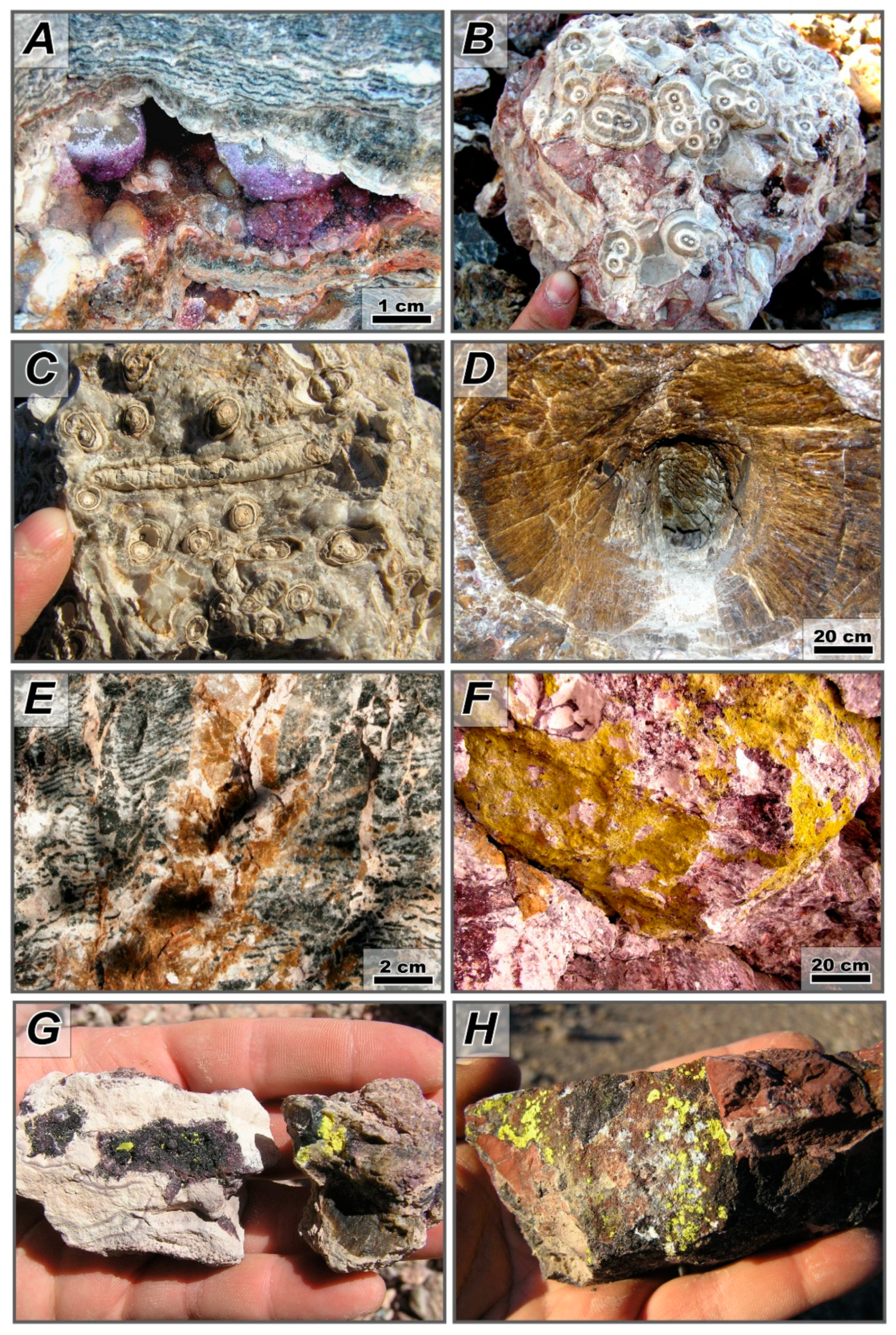
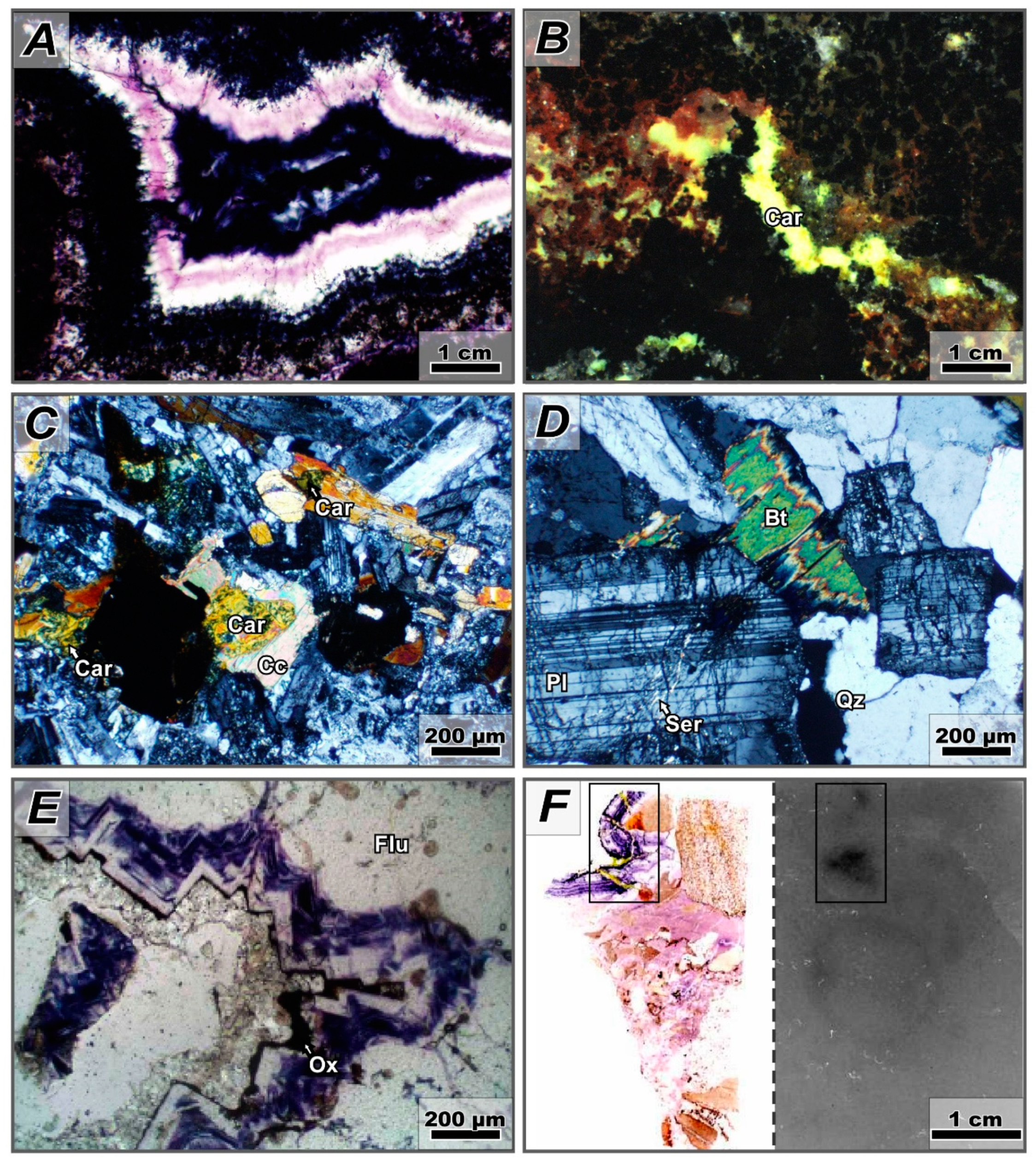
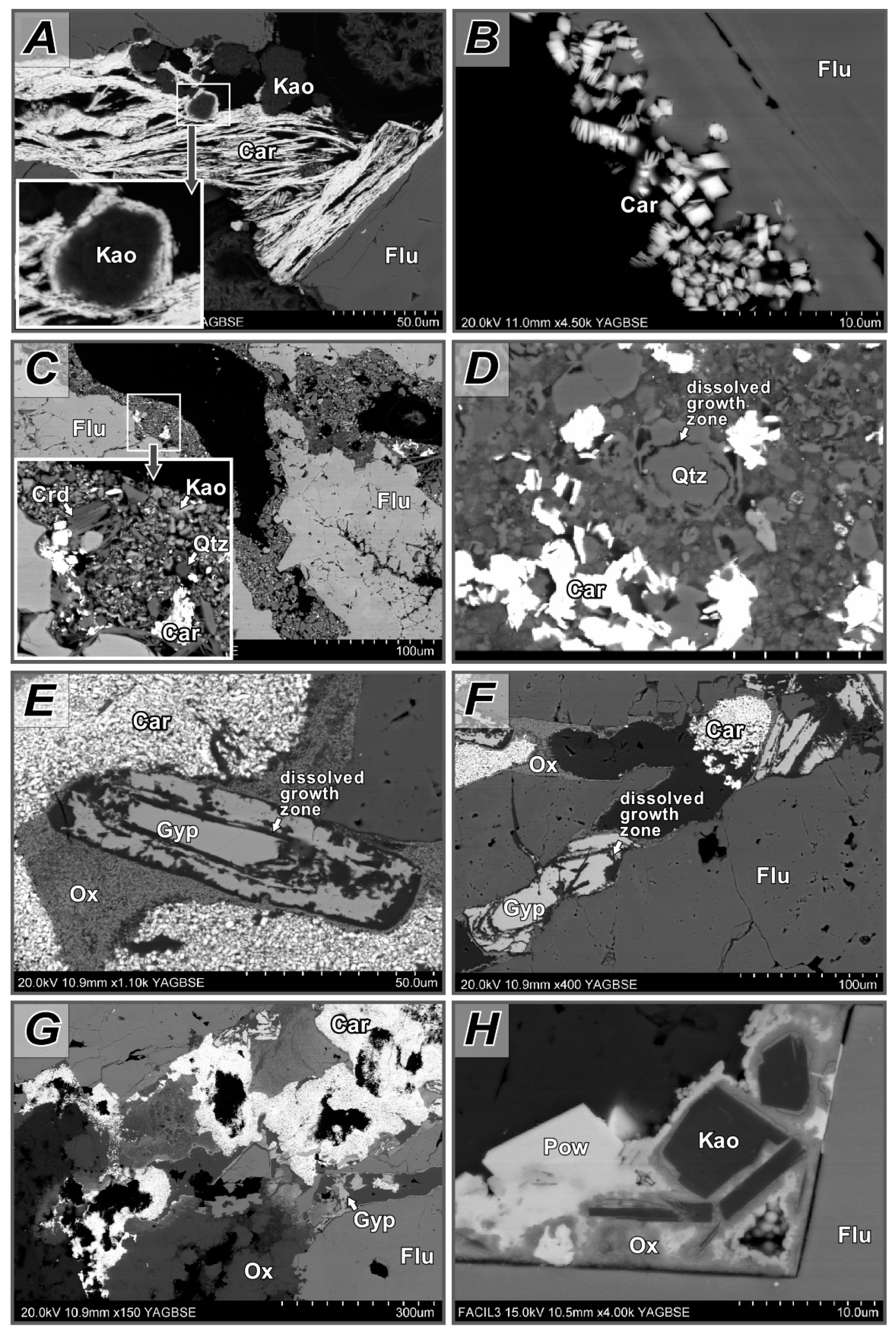
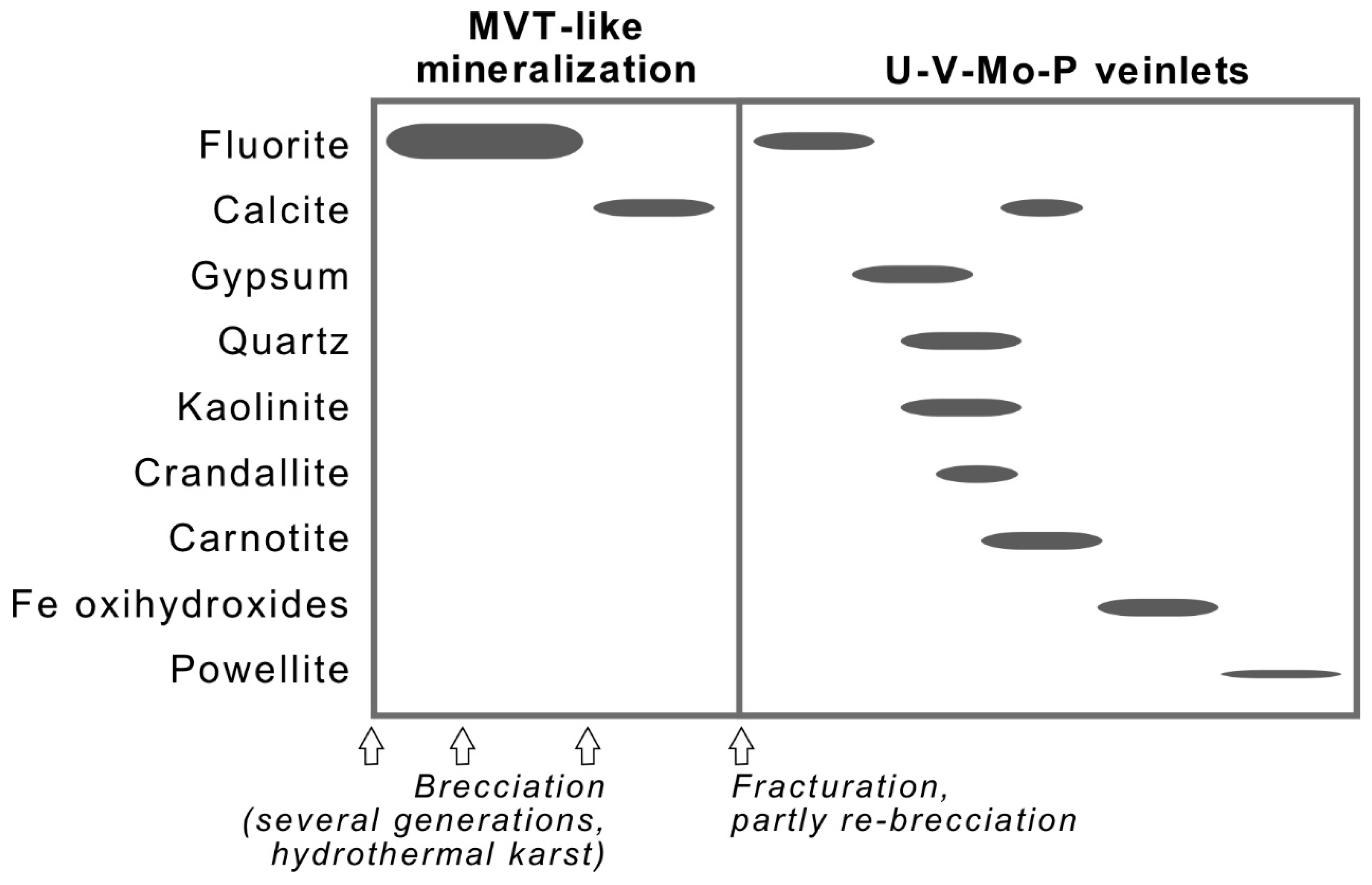
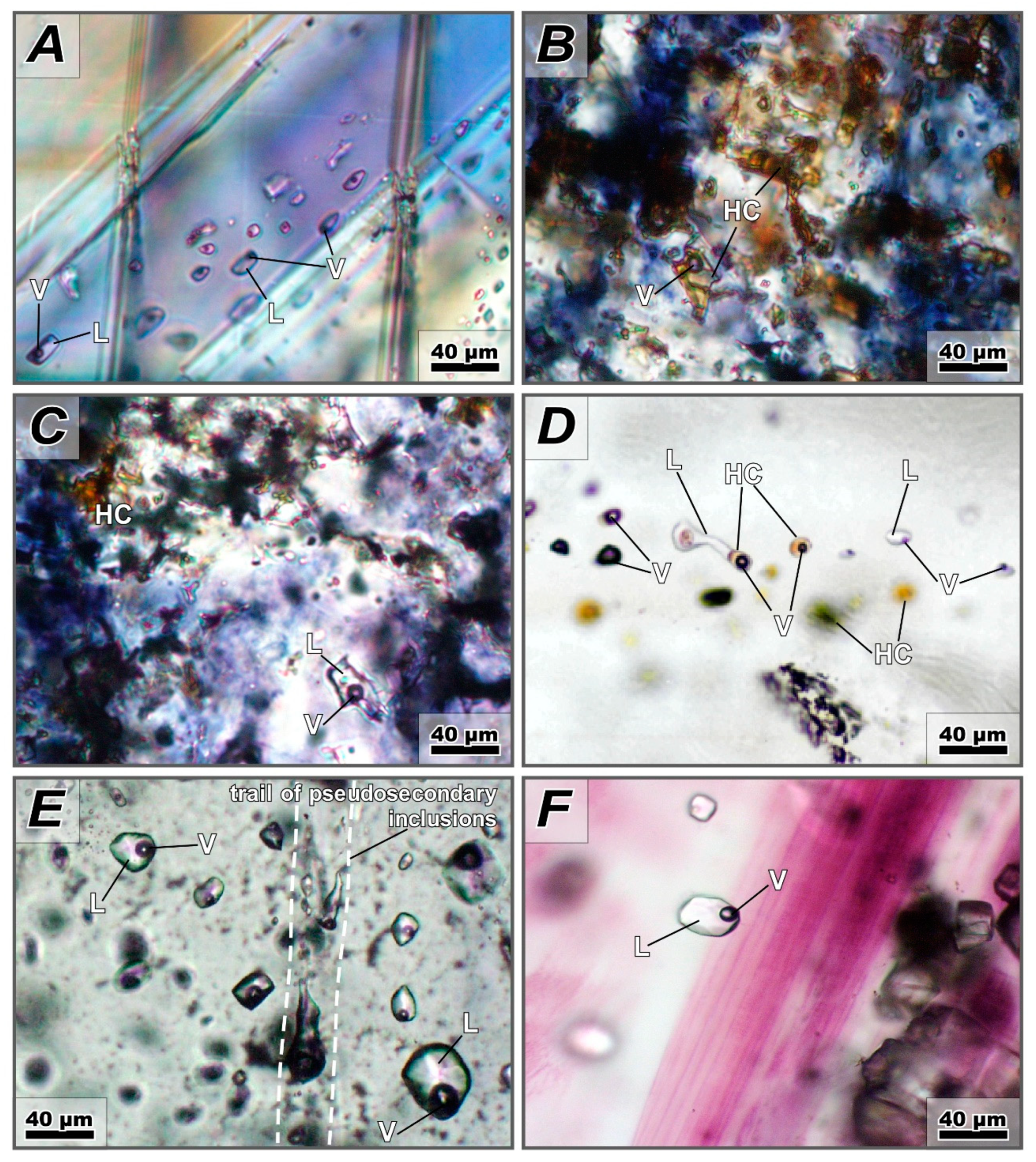
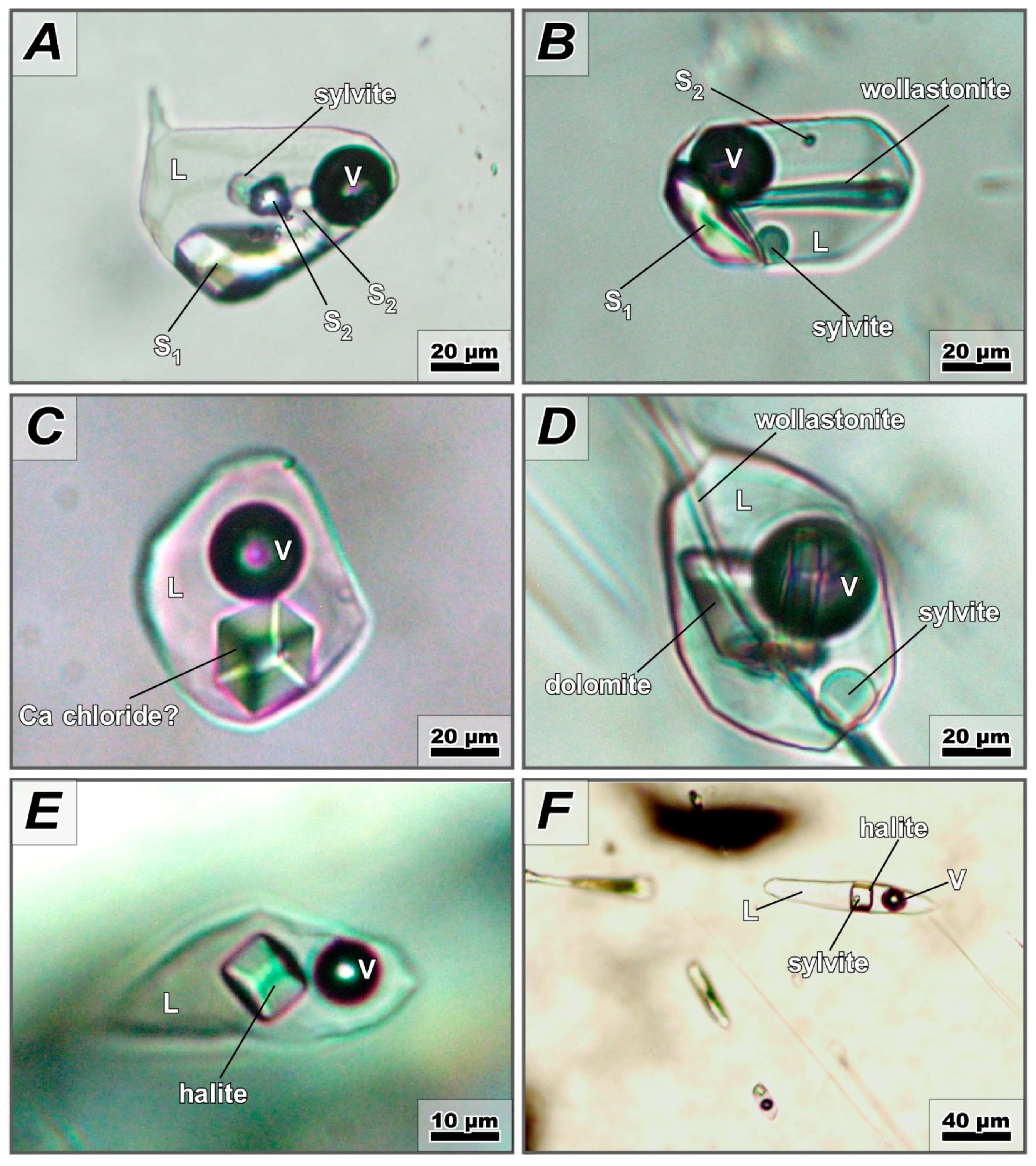
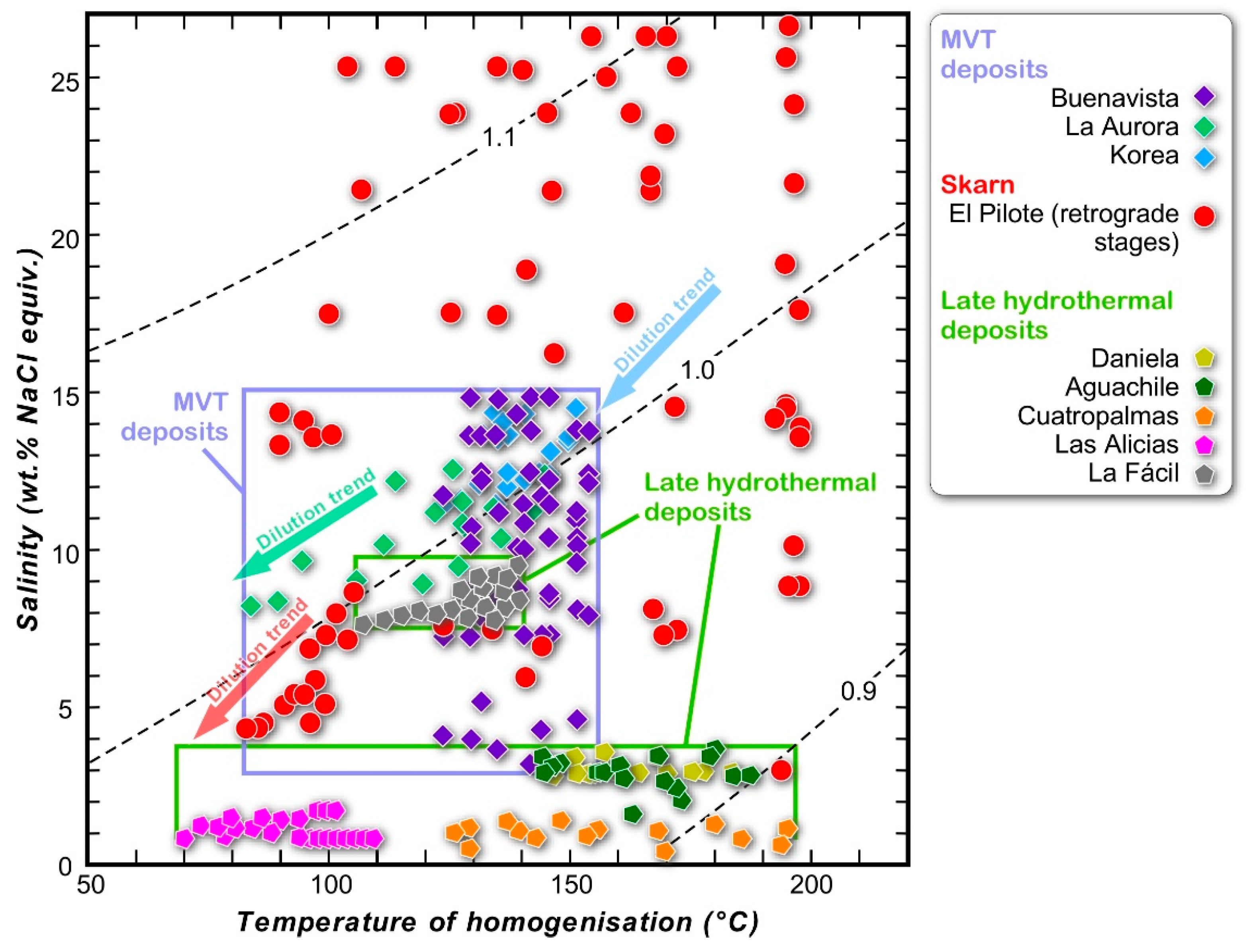
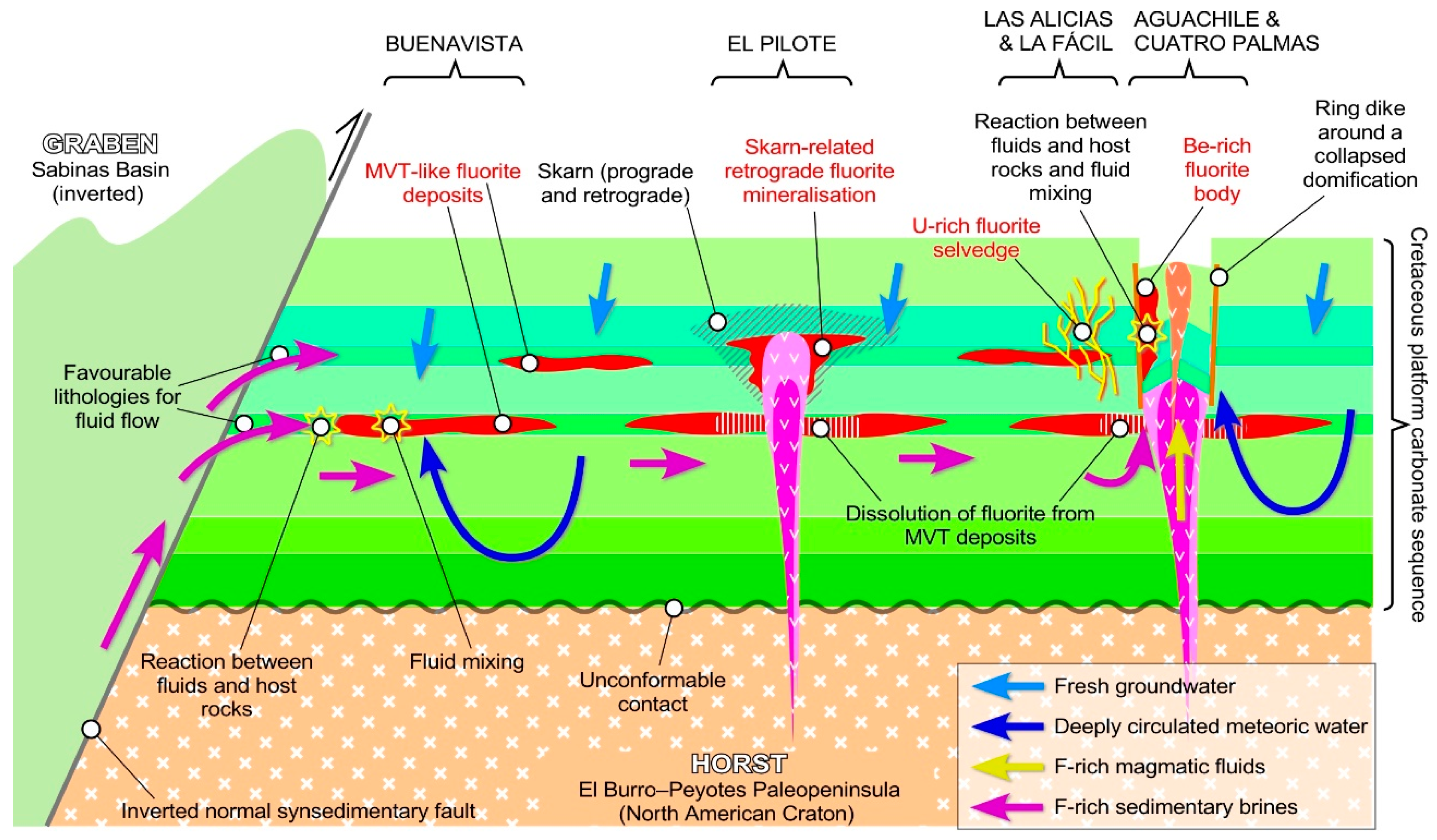
| Type of Deposit | Deposit Name | Further Information | Mineral | n | Type of Fluid Inclusions | Th range (°C) | Average Th (°C) | Ph (bar) | Tmi or Ts Range (°C) | Salinity Range (wt.% NaCl Equiv.) | Salinity Range (wt.% CaCl2) | Average Tmi or Ts (°C) | Average Salinity (wt.% NaCl Equiv.) | Average Salinity (wt.% CaCl2) |
|---|---|---|---|---|---|---|---|---|---|---|---|---|---|---|
| MVT-like deposits | Buenavista | fluorite | 500 | L + V | 115 to 152 | 135 | −4 to −11.5 | 5 to 15.5 | −10 | 13.9 | ||||
| fluorite | 50 | HC | 50 to 140 | 100 | ||||||||||
| La Aurora | fluorite | 60 | L + V | 130 to 136 | 133 | −10.4 | 14.4 | −10.4 | 14.3 | |||||
| fluorite | 70 | L + V + HC | 128 to 132 | 131 | −5.5 to −10 | 8.6 to 13.9 | −6 | 9.2 | ||||||
| fluorite | 60 | L + V + HC | 135 to 142 | 140 | −6.5 to −10 | 9.9 to 13.9 | −8 | 11.7 | ||||||
| fluorite | 45 | HC | 80 to 146 | 140 | ||||||||||
| calcite | 36 | L + V | 80 to 110 | 85 | −8.4 to −9.8 | 12.2 to 13.7 | −9 | 12.9 | ||||||
| Korea | fluorite | 58 | L + V | 128 to 140 | 133 | −11 | 15 | −11 | 15 | |||||
| fluorite | 52 | L + V | 114 to 132 | 126 | −10.5 | 14.5 | −10.5 | 14.5 | ||||||
| fluorite | 27 | L + V | 131 to137 | 134 | −8.2 to −9.1 | 11.8 to 13 | −8.9 | 12.7 | ||||||
| OVERALL MVT | 958 | 50 to 152 | 5 to 15.5 | |||||||||||
| Late hydrothermal deposits | Daniela | Be-rich | fluorite | 10 | L + V | 146 to 165 | 158 | 6 | −2.1 | 3.6 | −2.1 | 3.6 | ||
| fluorite | 15 | L + V | 136 to 143 | 140 | 4 | −2 | 3.4 | −2 | 3.4 | |||||
| Aguachile | Be-rich | fluorite | 20 | L + V | 134 to 150 | 146 | −1.9 | 3.2 | −1.9 | 3.2 | ||||
| fluorite | 27 | L + V | 165 to 172 | 170 | 7.7 | −2.1 | 3.6 | −2.1 | 3.6 | |||||
| fluorite | 3 | L + V | 146 | 146 | 4.5 | −2 | 3.4 | −2 | 3.4 | |||||
| Cuatropalmas | fluorite | 28 | L + V | 150 to 180 | 169 | 7 | −0.8 | 1.4 | −0.8 | 1.4 | ||||
| fluorite | 23 | L + V | 124 to 165 | 148 | −0.9 | 1.6 | −0.9 | 1.6 | ||||||
| fluorite | 30 | L + V | 144 to160 | 153 | −0.8 | 1.4 | −0.8 | 1.4 | ||||||
| calcite | 37 | L + V | 98 to 111 | 102 | 1.2 | −0.2 | 0.4 | −0.2 | 0.4 | |||||
| La Fácil | fluorite | 22 | L + V | 126 to 140 | 138 | −5 o −5.7 | 7.9 to 8.8 | −5.6 | 8.7 | |||||
| fluorite | 10 | L + V (HC) | 86 to 105 | 89 | ||||||||||
| fluorite | 20 | L + V | 107 to 140 | 133 | −5 o −5.2 | 7.9 to 8.1 | −5.1 | 8 | ||||||
| fluorite | 30 | HC | 107 to 120 | 113 | ||||||||||
| Las Alicias | Be- & U-rich | fluorite | 70 | L + V | 98 to 101 | 100 | −1 | 1.7 | −1 | 1.7 | ||||
| fluorite | 20 | L + V (HC) | 116 to 128 | 120 | ||||||||||
| fluorite | 50 | L + V | 95 to 110 | 102 | −0.5 | 0.9 | −0.5 | 0.9 | ||||||
| fluorite | 35 | HC | 105 to 116 | 112 | ||||||||||
| fluorite | 80 | HC | 90 to 106 | 104 | ||||||||||
| fluorite | 25 | L + V | 70 to 95 | 80 | −0.6 to −0.8 | 1.1 to 1.4 | −0.7 | 1.2 | ||||||
| OVERALL hydrothermal | 555 | 70 to 180 | 0.4 to 8.8 | |||||||||||
| Fluorite skarn | El Pilote | late veinlets | fluorite & calcite | 29 | L + V | 80 to 98 | 90 | 0.8 | −3 to −6 | 5 to 9.2 | −4 | 6.5 | ||
| stockwork | fluorite | 38 | L + V | 177 to 182 | 180 | 9 | −10 to −11.5 | 13.9 to 15.5 | −10.5 | 14.5 | ||||
| stratabound | fluorite | 33 | L + V * | 116 to 121 | 119 | −28 to −31 | 24.8 to 26 | −30 | 25.5 | |||||
| stratabound | fluorite | 50 | L + V | 179 to 182 | 181 | 8.7 | −10 to −11.5 | 13.9 to 15.5 | −10.8 | 14.8 | ||||
| stratabound | fluorite | 45 | L + V | 126 to 129 | 128 | 3.6 | −2.2 to −6 | 3.7 to 9.2 | −5.7 | 8.8 | ||||
| stratabound | fluorite | 51 | L + V * | 115 to 117 | 116 | −27 to −29 | 24.5 to 25.2 | −28 | 24.8 | |||||
| stratabound | calcite | 60 | L + V * | 78 to 105 | 95 | −31 to −34 | 26 to 26.9 | −33 | 26.5 | |||||
| skarn | garnet | 4 | L + V * | 380 to 394 | 387 | 205 | −28 to −42 | 24.8 to 29.1 | −29 | 25.2 | ||||
| skarn | calcite | 40 | L + V + S | 200 to 250 | 240 | 33 | 180 to 230 | 30 to 34 | 220 | 32 | ||||
| OVERALL skarn | 350 | 78 to 394 | 3.7 to 34 | 24.8 to 29.1 | ||||||||||
| Case Example | Type of Deposit | Substances | Model of Formation | T (°C) | Salinity (wt.% NaCl Equivalent) | Comments | References |
|---|---|---|---|---|---|---|---|
| Las Cuevas & Río Verde, San Luis Potosí | Skarn-related | Fluorite | Contact metamorphism and retrograde hydrothermal fluids from F-rich volcanic rocks | 60 to 130 | ~0 | [38] | |
| MVT | Diluted basinal brines reacting with host limestones | 60 to 110 | 0 to 0.2 | [32] | |||
| MVT-like | Diluted basinal brines reacting with F-rich modified meteoric water and host limestones | 49 to 177 | 0 to 1.9 (mostly 0.2) | In this paper, we favour this model | [37] | ||
| Bolaños & San Martín de Bolaños, Jalisco | Epithermal | Polymetallic, rich in fluorite | Essentially Ag-rich intermediate sulphidation deposits with stages of mineralisation very rich in fluorite, deposited through boiling or conductive cooling | 150 to 340 | 0 to 16 | [39,40,41,42] | |
| Several small deposits in Central Mexico | Tin rhyolites | Sn | Fumarolic deposits associated with extremely differentiated F-rich rhyolites and rhyodacites | n.a. | n.a. | [3,43] | |
| Buenavista, Coahuila | MVT | Fluorite | Dense F-rich basinal brines that reacted with platform and reefal carbonates | 50 to 155 | 5.7 to 18.1 | [1,2,9,10,11,12], this paper | |
| El Pilote, Coahuila | Skarn | Fluorite | Shallow hypabyssal rocks with associated hydrothermal fluids that dissolved pre-existing MVT-like fluorite mantos, and fluorite re-precipitated around the skarn | 78 to 423 | 5 to 34 | Also, 24.5 to 29.1 wt.% CaCl2 fluids | [20,21], this paper |
| Aguachile & Cuatro Palmas, Coahuila | Shallow hydro-thermal | Fluorite, Be, U, Mo, etc. | Fluids largely exsolved from cooling hypabyssal alkaline to calc-alkaline rocks that reacted with host carbonate rocks | 70 to 180 | 0.9 to 8.8 | Fluids generally below 4 wt.% NaCl equivalent | [5,6], this paper |
© 2019 by the authors. Licensee MDPI, Basel, Switzerland. This article is an open access article distributed under the terms and conditions of the Creative Commons Attribution (CC BY) license (http://creativecommons.org/licenses/by/4.0/).
Share and Cite
Camprubí, A.; González-Partida, E.; Richard, A.; Boiron, M.-C.; González-Ruiz, L.E.; Aguilar-Ramírez, C.F.; Fuentes-Guzmán, E.; González-Ruiz, D.; Legouix, C. MVT-Like Fluorite Deposits and Oligocene Magmatic-Hydrothermal Fluorite–Be–U–Mo–P–V Overprints in Northern Coahuila, Mexico. Minerals 2019, 9, 58. https://doi.org/10.3390/min9010058
Camprubí A, González-Partida E, Richard A, Boiron M-C, González-Ruiz LE, Aguilar-Ramírez CF, Fuentes-Guzmán E, González-Ruiz D, Legouix C. MVT-Like Fluorite Deposits and Oligocene Magmatic-Hydrothermal Fluorite–Be–U–Mo–P–V Overprints in Northern Coahuila, Mexico. Minerals. 2019; 9(1):58. https://doi.org/10.3390/min9010058
Chicago/Turabian StyleCamprubí, Antoni, Eduardo González-Partida, Antonin Richard, Marie-Christine Boiron, Luis E. González-Ruiz, César F. Aguilar-Ramírez, Edith Fuentes-Guzmán, Daniel González-Ruiz, and Claire Legouix. 2019. "MVT-Like Fluorite Deposits and Oligocene Magmatic-Hydrothermal Fluorite–Be–U–Mo–P–V Overprints in Northern Coahuila, Mexico" Minerals 9, no. 1: 58. https://doi.org/10.3390/min9010058
APA StyleCamprubí, A., González-Partida, E., Richard, A., Boiron, M.-C., González-Ruiz, L. E., Aguilar-Ramírez, C. F., Fuentes-Guzmán, E., González-Ruiz, D., & Legouix, C. (2019). MVT-Like Fluorite Deposits and Oligocene Magmatic-Hydrothermal Fluorite–Be–U–Mo–P–V Overprints in Northern Coahuila, Mexico. Minerals, 9(1), 58. https://doi.org/10.3390/min9010058





